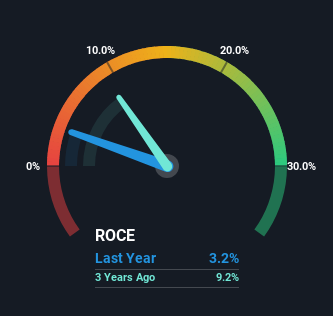- United States
- /
- Chemicals
- /
- NYSE:MATV
Returns On Capital At Mativ Holdings (NYSE:MATV) Paint A Concerning Picture
What are the early trends we should look for to identify a stock that could multiply in value over the long term? Firstly, we'll want to see a proven return on capital employed (ROCE) that is increasing, and secondly, an expanding base of capital employed. Ultimately, this demonstrates that it's a business that is reinvesting profits at increasing rates of return. Although, when we looked at Mativ Holdings (NYSE:MATV), it didn't seem to tick all of these boxes.
Return On Capital Employed (ROCE): What Is It?
If you haven't worked with ROCE before, it measures the 'return' (pre-tax profit) a company generates from capital employed in its business. To calculate this metric for Mativ Holdings, this is the formula:
Return on Capital Employed = Earnings Before Interest and Tax (EBIT) ÷ (Total Assets - Current Liabilities)
0.032 = US$104m ÷ (US$3.7b - US$469m) (Based on the trailing twelve months to March 2023).
So, Mativ Holdings has an ROCE of 3.2%. Ultimately, that's a low return and it under-performs the Chemicals industry average of 11%.
See our latest analysis for Mativ Holdings

In the above chart we have measured Mativ Holdings' prior ROCE against its prior performance, but the future is arguably more important. If you'd like, you can check out the forecasts from the analysts covering Mativ Holdings here for free.
SWOT Analysis for Mativ Holdings
- Dividend is in the top 25% of dividend payers in the market.
- Interest payments on debt are not well covered.
- Shareholders have been diluted in the past year.
- Expected to breakeven next year.
- Has sufficient cash runway for more than 3 years based on current free cash flows.
- Good value based on P/S ratio and estimated fair value.
- Debt is not well covered by operating cash flow.
- Paying a dividend but company is unprofitable.
What Does the ROCE Trend For Mativ Holdings Tell Us?
In terms of Mativ Holdings' historical ROCE movements, the trend isn't fantastic. Over the last five years, returns on capital have decreased to 3.2% from 9.9% five years ago. Although, given both revenue and the amount of assets employed in the business have increased, it could suggest the company is investing in growth, and the extra capital has led to a short-term reduction in ROCE. And if the increased capital generates additional returns, the business, and thus shareholders, will benefit in the long run.
What We Can Learn From Mativ Holdings' ROCE
Even though returns on capital have fallen in the short term, we find it promising that revenue and capital employed have both increased for Mativ Holdings. However, despite the promising trends, the stock has fallen 54% over the last five years, so there might be an opportunity here for astute investors. As a result, we'd recommend researching this stock further to uncover what other fundamentals of the business can show us.
Mativ Holdings does come with some risks though, we found 3 warning signs in our investment analysis, and 2 of those shouldn't be ignored...
While Mativ Holdings may not currently earn the highest returns, we've compiled a list of companies that currently earn more than 25% return on equity. Check out this free list here.
New: Manage All Your Stock Portfolios in One Place
We've created the ultimate portfolio companion for stock investors, and it's free.
• Connect an unlimited number of Portfolios and see your total in one currency
• Be alerted to new Warning Signs or Risks via email or mobile
• Track the Fair Value of your stocks
Have feedback on this article? Concerned about the content? Get in touch with us directly. Alternatively, email editorial-team (at) simplywallst.com.
This article by Simply Wall St is general in nature. We provide commentary based on historical data and analyst forecasts only using an unbiased methodology and our articles are not intended to be financial advice. It does not constitute a recommendation to buy or sell any stock, and does not take account of your objectives, or your financial situation. We aim to bring you long-term focused analysis driven by fundamental data. Note that our analysis may not factor in the latest price-sensitive company announcements or qualitative material. Simply Wall St has no position in any stocks mentioned.
About NYSE:MATV
Mativ Holdings
Manufactures and sells specialty materials in the United States, Europe, the Asia Pacific, the Americas, and internationally.
Good value with moderate growth potential.
Similar Companies
Market Insights
Community Narratives




